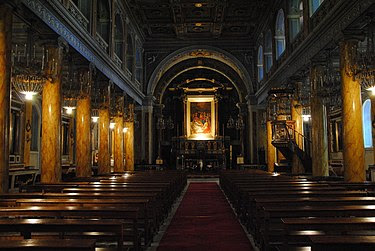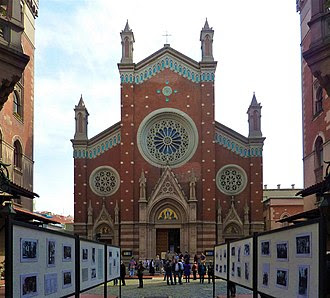Basilicas in the Holy Land and Central Asia
This blog covers basilicas in the Holy Land, Kazakhstan, and Turkey.
The Holy Land
I blogged about the following basilica on April 8, 2019.
- Basilica of the Holy Sepulchre, Jerusalem.
Basilica of the Agony, Jerusalem
Considered a basilica since ancient times.
The Church of All Nations or the Basilica of the Agony is located on the Mount of Olives next to the Garden of Gethsemane. Inside is the rock on which Jesus prayed before his Passion and Death. The current Basilica rests on the foundations of a 4th Century church destroyed by an earthquake and a 12th Century church abandoned after the Crusades. The current Basilica was built between 1919 and 1924. The name “Church of All Nations” derives from donations made primarily from 12 nations. The Neo-classical building was constructed with two types of locally quarried stone. Alabaster panels died violet induce a mood of depression to commemorate Christ’s agony and the dark blue ceiling invokes a night sky. The Basilica is administered by the Franciscans.
The first picture is from Disolve, the second from Pinterest, and the rest from Wikipedia.
Basilica of the Transfiguration, Mount Tabor
Considered a basilica since ancient times.
The Transfiguration is described in the New Testament as the time when a glorified Jesus appeared with Moses and Elijah. The Bible only says that it took place on top of a mountain but does not name the mountain. Traditionally, the mountain is thought to be Mount Tabor. Churches have occupied the site since the early days of Christianity, but the current Franciscan monastery complex, of which the Basilica is part, was completed in 1924. The Basilica has three chapels, one for Jesus, one for Moses, and one for Elijah, and is designed for maximum lighting in keeping with the theme of the Transfiguration.
The first picture is from Pinterest and the rest from Wikipedia.
Basilica of the Annunciation, Nazareth
Considered a basilica since ancient times.
The Basilica is built on the site of the Archangel Gabriel’s appearance to the Virgin Mary to announce that she would conceive and bear Jesus, the Son of God. At least four churches have occupied the site since 427 prior to the construction of the current Basilica from 1960 to 1969. It was designed by an Italian architect in a style described as Italian Brutalist. The upper level contains the church, while on the lower level, there is a grotto believed to be the site of the Annunciation. The church and the walls of the courtyard contain dozens of mosaics of Mary donated by various countries and executed with themes and styles native to those countries. The Basilica is operated by the Franciscans.
The first picture is from Flickr and the rest from Wikipedia.
Carmelite Monastery of Stella Maris (Our Lady, Star of the Sea), Haifa
Declared a minor basilica by Pope Gregory XVI in 1839.
Monks have lived on Mount Carmel since the 12th Century and these monks eventually became the Carmelites. The current monastery opened in 1836 but spent most of the 20th Century occupied by either the British Army or the Israeli Army. The dome of the monastery’s church has colorful paintings depicting scenes from the Old and New Testaments, including one of the Prophet Elijah ascending to heaven in a chariot of fire. The main altar sits above a cave associated with Elijah.
All pictures are from Wikipedia.
Basilica of St. Stephen, Jerusalem
Declared a minor basilica by Pope Pius X in 1903.
The Basilica is located at one of two sites thought to be the location of the martyrdom of St. Stephen—the first Christian martyr. The first church on this site was built in the 5th Century but was destroyed in 614. French Dominicans bought the property in the 19th Century and opened the current Basilica in 1900.
Pictures are from Wikipedia.
Basilica of Emmaus, Emmaus
Declared a minor basilica by Pope Benedict XV in 1919.
The Basilica commemorates when Our Risen Lord met the disciples, including Cleopas, on the road to Emmaus. Unfortunately, no one today knows for sure where this event took place or even where the Biblical Emmaus was located. The Basilica stands on the site of Cleopas’ house. The Basilica dates to the 19th Century and is served by the Franciscans.
From a local website.
Basilica of St. Anne, Jerusalem
Declared a minor basilica by Pope Pius XII in 1954.
A church was built in the 5th Century in this location to mark the childhood home of the Blessed Virgin Mary, but this church was destroyed in 614. The current Romanesque basilica was built between 1131 and 1138 and honors Mary and her parents, Anne and Joachim. After Muslims, under Saladin, conquered Jerusalem in 1187, the church became a Muslim school. The Ottoman sultan gave the church to the French Government in 1856 and the building was restored. It was during the restoration period that the Pool of Bethesda was rediscovered within the basilica complex. The Basilica is administrated by the Missionaries of Africa, commonly known as the White Fathers. The Basilica has excellent acoustics and is said to be especially suited to Gregorian chant.
Both pictures are from Wikipedia.
Dormition Abbey Basilica of the Virgin Mary, Jerusalem
Declared a minor basilica by Pope Pius XII in 1957.
The Basilica commemorates the location of where the Blessed Virgin Mary was assumed into eternal life. A church was built at this location in the 4th Century but was destroyed in 614. A 12th Century church met the same fate. The current Neo-Romanesque basilica was built between 1900 and 1910. The building is circular with four towers and is staffed by Benedictines.
The first picture is from a local website and the others are from Wikipedia.
Kazakhstan
Basilica of St. Joseph, Karaganda
Declared a minor basilica by Pope Francis in 2020.
The Basilica opened in 1980 and was the first Catholic church in what was then the Kazakh Soviet Socialist Republic. It was built for and at the request of Catholics from Germany and Eastern Europe who had been exiled there by the Soviet Union. More than a million political prisoners were forced to work in the mines near Karaganda by the Soviets. Kazakhstan gained its independence in 1991 and in 1999, the church became the cathedral for the Diocese of Karaganda. A new cathedral was built in 2012. The Basilica contains relics of Blessed Władysław Bukowiński, a priest who spent more than 10 years in Soviet gulags proclaiming the Gospel to the other prisoners sentenced to forced labor.
From Catholic News Agency
Turkey
Cathedral Basilica of the Holy Spirit, Istanbul
Declared a minor basilica by Pope Pius X in 1909.
The Basilica serves as the Cathedral for the Roman-rite Apostolic Vicariate of Istanbul. The Baroque church was built in 1846. It has marble columns and coffered ceilings and has been visited by four recent Popes.
From Blogspot, Flickr, and Wikipedia.
St. Anthony of Padua Basilica, Istanbul
Declared a minor basilica by Pope Pius XI in 1932.
The Neo-Gothic Basilica was built between 1906 and 1912 to replace an 18th Century church. The church has long served Istanbul’s Italian community. Today, the church has weekend Masses celebrated in Italian, Polish, English, and Turkish. The future Pope John XXIII served at this church for ten years when he was the Vatican’s ambassador to Turkey.
All pictures are from Wikipedia.




























































